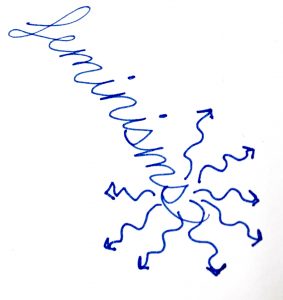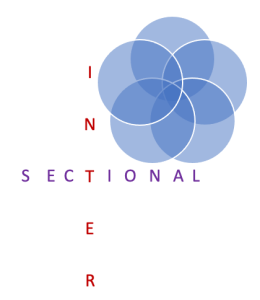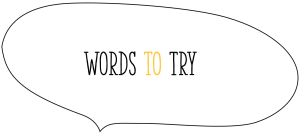6 Conservative, Eco-, Anti-Racist, and Intersectional Feminisms
Rebecca Yoshizawa

It’s very common to assume that feminism is just one specific way of thinking. It is sometimes associated with “hating men” and other negative stereotypes. (By the way, anyone can be a feminist, including men). Often, people understand that feminists critique sexism, or that they seek equality; however, many people don’t know much more about feminism than that.
Properly, we need to develop our concept of feminism into “feminisms”; there is more than one way to be feminist, and many different definitions of feminism. There are many different types of feminism, and some of them deeply contradict or actively critique one another.
For example, where liberal, socialist, and radical feminisms see that sex/gender inequality is rooted in problematic assumptions about women and the feminine gender, conservative feminism embraces femininity and stricter gender roles for women. However, conservative feminism critiques the lack of value that society has for the roles and work of women. Conservative feminism can take the position, for example, that women are designed for or particularly talented at mothering, and that in order to create a just society, this role should be recognized, supported, and celebrated. Child support laws and reinforcement of child support orders might reflect conservative feminist values as much as they do liberal and socialist feminist ones. Conservative feminism may also be associated with religion: for example, Christians advocating for a greater role of women in their churches.

Some feminisms expand the scope well beyond sex and gender. Ecofeminism pairs a critical gender analysis with environmentalism. Ecofeminists identify the the causes of environmental degradation, pollution, and climate change as having the same origin as the oppressions of patriarchy, racism, and classism. For instance, ecofeminists argue that racialized and impoverished communities are more likely to be polluted by industry and more severely affected by natural disasters. Ecofeminists also sometimes suggest that women have a special relationship to nature, illustrated by a “Mother Earth” figure.
Other feminisms look at the intersection of gender and race. Anti-racist feminisms identify that feminism has focused on and most benefitted women in the west, particularly as it has lacked an understanding of how racism intersects with sexism. For instance, post-colonial feminism argues that colonialism disproportionately marginalizes women. Feminist activism should be developed indigenously, instead of by feminists with “white saviour,” ethnocentric ideas about gender equality. For example, where liberal and racial feminists would critique the Muslim practice of women wearing veils (hijab, burqa) as internalized misogyny, post-colonial feminists identify how veils can form a basis of shared identity, signify faith, and provide protection.
Ultimately, this workbook is informed by a intersectional approach, which can draw from many different modes of analysis. The term “intersectionality” refers to a framework of analysis that identifies relationships between systems of oppression and privilege. The basic insight of intersectional analyses is that oppressions arise in the interrelationships between constructed social categories; oppressions are not independent of each other but work together. Intersectionality therefore recognizes, for example, the double discrimination of sexism and racism that women of colour experience. Intersectionality addresses how poverty is exacerbated by racism.
Intersectional analyses also identify the supposed universal category or experience of “women” as problematic. Where some feminists claim to speak for and understand the experiences of all women, it was black feminists who argued that liberal and radical feminisms did not address their experiences. Intersectional feminism therefore recognizes that a person could, for instance, experience oppression with regards to their sex and gender, but privilege with regards to their race, such as in the case of women with white privilege. Intersectional analyses also identify that the benefits of patriarchy are not equally distributed among all men. Race, class, gender, sex, sexuality, ability, age, citizenship status, and more are kinds of social categorization and hierarchy that are examined by intersectional feminists.
 Feminisms: theories, analyses, and practices (such as activism) that address the roles of gender, sex, and sexuality in social phenomena
Feminisms: theories, analyses, and practices (such as activism) that address the roles of gender, sex, and sexuality in social phenomena
Misogyny: hatred towards women
Ethnocentrism: evaluating other cultures by comparing them to one’s own; ideology that one’s own culture is superior to others
Intersectionality: a concept describing the interconnected and overlapping nature of social oppressions and privileges
Ecofeminism: a movement and analysis that identifies sexism, racism, classism, and ecological/environmental degradation as having the same cause in patriarchy, colonialism, and other social oppressions
Anti-racist feminisms: diverse perspectives/movements that seek to reveal the interlocking relationships between sexism, colonialism, and racism
Conservative feminism: arguments and movements to celebrate and support women’s traditional social roles
Privilege: an advantage, special right, or benefit that only a certain group or person has
Hierarchy: a ranked system in which groups of people are organized according to status
Racism: discrimination on the basis of real or presumed membership within particular racialized groups; belief that some racial groups are superior/inferior
theories, analyses, and practices (such as activism) that address the roles of gender, sex, and sexuality in social phenomena
hatred towards women
evaluating other cultures by comparing them to one's own; ideology that one's own culture is superior to others
a concept describing the interconnected and overlapping nature of social oppressions and privileges
a movement and analysis that identifies sexism, racism, classism, and ecological/environmental degradation as having the same cause in patriarchy, colonialism, and other social oppressions
diverse perspectives/movements that seek to reveal the interlocking relationships between sexism, colonialism, and racism
arguments and movements to celebrate and support women's traditional social roles
an advantage, special right, or benefit that only a certain group or person has
a ranked system in which groups of people are organized according to status
discrimination on the basis of real or presumed membership within particular racialized groups; belief that some racial groups are superior/inferior

